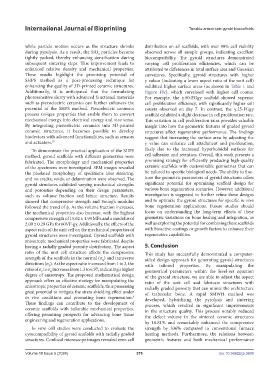Page 387 - IJB-10-5
P. 387
International Journal of Bioprinting Tunable anisotropic gyroid bioscaffolds
while particle motion occurs as the structure shrinks distribution on all scaffolds, with over 98% cell viability
during pyrolysis. As a result, the SiO particles become observed across all sample groups, indicating excellent
2
tightly packed, thereby enhancing densification during biocompatibility. The gyroid structures demonstrated
subsequent sintering steps. This improvement leads to varying cell proliferation efficiencies, which can be
enhanced relative density and mechanical properties. attributed to differences in total surface area and Gaussian
These results highlight the promising potential of curvatures. Specifically, gyroid structures with higher
SHPS method as a post-processing technique for γ values (indicating a lower aspect ratio of the unit cell)
enhancing the quality of 3D-printed ceramic structures. exhibited higher surface areas (as shown in Table 1 and
Additionally, it is anticipated that the formulating Figure 10c), which correlated with higher cell counts.
photosensitive slurry with advanced functional materials For example, the γ.50-FGgy scaffold showed superior
such as piezoelectric ceramics can further enhances the cell proliferation efficiency, with significantly higher cell
potential of the SHPS method. Piezoelectric ceramics counts observed on day 7. In contrast, the γ.25-FGgy
possess unique properties that enable them to convert scaffold exhibited a slight decrease in cell proliferation rate.
mechanical energy into electrical energy and vice versa. This variation in cell proliferation rates provides valuable
By integrating piezoelectric ceramics into 3D-printed insight into how the geometric features of graded gyroid
ceramic structures, it becomes possible to develop structures affect regenerative performance. The findings
biodevices with advanced functionalities, such as sensors suggest that increasing the surface area by adjusting the
and actuators. 38 γ value can enhance cell attachment and proliferation,
To demonstrate the practical application of the SHPS likely due to the increased hyperboloidal surfaces for
method, gyroid scaffolds with different geometries were cell adhesion and retention. Overall, this work presents a
fabricated. The morphology and mechanical properties promising strategy for efficiently producing high-quality
of the specimens were investigated. SEM images revealed ceramic scaffolds with customizable geometries that can
the pixelated morphology of specimens after sintering, be tailored to specific biological needs. The ability to fine-
and no cracks, voids, or delamination were observed. The tune the geometric parameters of gyroid structures offers
gyroid structures exhibited varying mechanical strengths significant potential for optimizing scaffold design for
and porosities depending on their design parameters, various bone regeneration scenarios. However, additional
such as volume fraction and lattice structure. Results investigation is suggested to further refine these designs
showed that compressive strength and Young’s modulus and to optimize the gyroid structures for specific in vivo
followed the trend of ϕ. As the volume fraction increases, bone regeneration applications. Future studies should
the mechanical properties also increase, with the highest focus on understanding the long-term effects of these
compressive strength of 15.62 ± 1.94 MPa and a modulus of geometric variations on bone healing and integration, as
2.09 ± 0.29 GPa for 60VF-gy. Additionally, the effects of the well as exploring the potential for combining these scaffolds
aspect ratio of the unit cell on the mechanical properties of with bioactive coatings or growth factors to enhance their
gyroid structures were investigated. Gyroid scaffolds with regenerative capabilities.
anisotropic mechanical properties were fabricated despite
having a radially graded porosity distribution. The aspect 5. Conclusion
ratio of the unit cell structure affects the compressive This study has successfully demonstrated a computer-
strength of the scaffolds in the normal (σ ) and transverse aided design approach for generating gyroid structures
N
directions (σ ). As the aspect ratio increased from 1 to 2, the with tailored properties. By manipulating the
T
ratio of σ to σ increases from 1.3 to 6.97, indicating a higher geometrical parameters within the level-set equation
N
T
degree of anisotropy. The proposed mathematical design of the gyroid structure, we are able to adjust the aspect
approach offers an effective strategy for manipulating the ratio of the unit cell and fabricate structures with
anisotropic properties of ceramic scaffolds, thus possessing radially graded porosity that can mimic the architecture
great potential to mitigate the stress shielding effect under of trabecular bone. A rapid SMWH method was
8
in vivo conditions and promoting bone regeneration. developed, hybridizing the pyrolysis and sintering
These findings can contribute to the development of process, which resulted in significant improvements
ceramic scaffolds with tailorable mechanical properties, in the structure quality. This process notably reduced
offering promising prospects for advancing bone tissue the defect volume in the sintered ceramic structures
engineering and regeneration applications. by 16.81% and remarkably enhanced the compressive
In vitro cell studies were conducted to evaluate the strength by 336% compared to conventional furnace
cytocompatibility of gyroid scaffolds with radially graded heating methods. Furthermore, the relations between
structures. Confocal microscope images revealed even cell geometric features and both mechanical performance
Volume 10 Issue 5 (2024) 379 doi: 10.36922/ijb.3609

